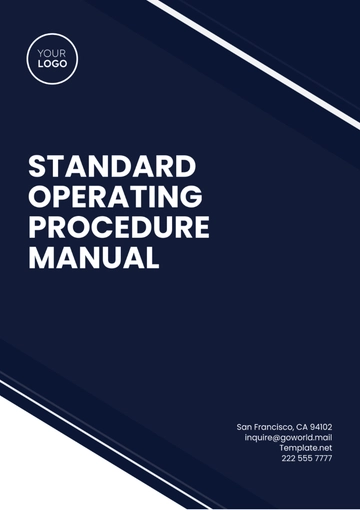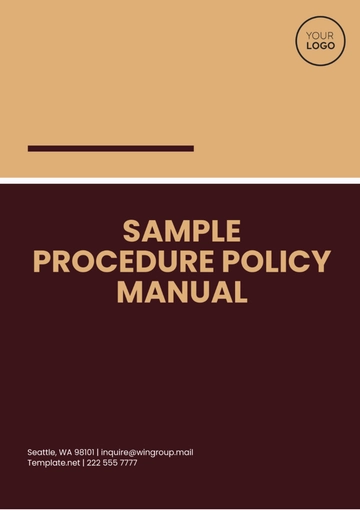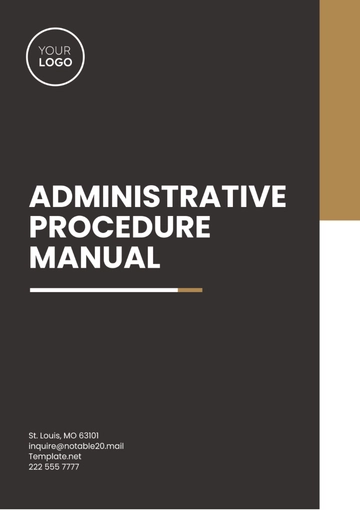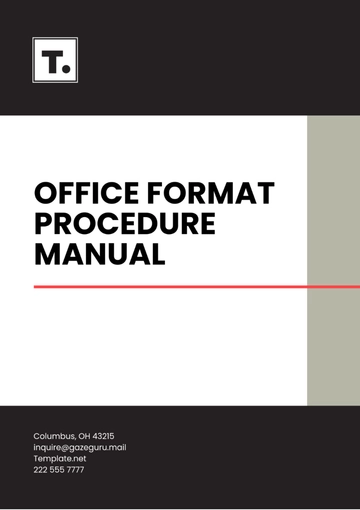Free Agriculture Equipment Management Policy & Procedure Manual

1. Introduction
1.1 Purpose
The purpose of this manual is to provide [Your Company Name] with comprehensive guidelines for maintaining, operating, and managing agricultural equipment. These guidelines are meticulously crafted to enhance equipment longevity, ensure the highest standards of safety, and minimize downtime. By adhering to these policies, [Your Company Name] aims to optimize operational efficiency and extend the service life of its agricultural machinery, thereby supporting sustainable agricultural practices and maximizing productivity.
1.2 Scope
The procedures and policies outlined in this manual apply to all employees who operate, maintain, or manage agricultural equipment at [Your Company Name]. This includes, but is not limited to, equipment operators, maintenance personnel, and supervisors. Each role is defined with specific responsibilities and expectations to ensure that every piece of equipment is handled with the utmost care and professionalism. Adherence to these guidelines is mandatory to uphold the integrity and safety of our operations.
1.2 Policy Compliance
Compliance with the policies set forth in this manual is mandatory for all relevant staff at [Your Company Name]. Regular training and audits will be conducted to ensure that all personnel are knowledgeable and compliant with these procedures. Non-compliance or negligence in following these guidelines will result in disciplinary actions, as outlined in the company's code of conduct. It is the responsibility of each employee to familiarize themselves with this manual and implement the procedures in their daily tasks to maintain a safe and efficient working environment.
2. Equipment Maintenance
Ensure optimal performance and longevity of agricultural equipment with structured maintenance schedules. Regular inspections and systematic upkeep procedures outlined in this manual aim to minimize downtime and enhance operational efficiency at [Your Company Name].
2.1 Routine Maintenance Schedules
Equipment Type | Maintenance Task | Frequency |
|---|---|---|
Tractors | Oil Change | Every 100 hours |
Tractors | Tire Pressure Check | Weekly |
Tractors | Hydraulic System Check | Monthly |
Combine Harvesters | Blade Sharpening | Every 200 hours |
Combine Harvesters | Engine Inspection | Monthly |
Combine Harvesters | Grain Tank Cleaning | After Each Use |
Irrigation Systems | Filter Cleaning | Monthly |
Irrigation Systems | Pipe Inspection | Quarterly |
Irrigation Systems | Pump Maintenance | Annually |
Plows | Bolt Tightening | Every 50 hours |
Plows | Blade Replacement | Annually |
Seeders | Calibration Check | Before Each Season |
Seeders | Lubrication | Monthly |
2.2 Maintenance Logs
All maintenance activities should be logged in the Equipment Maintenance Logbook. Each entry should include the date, type of maintenance performed, and the name of the technician.
Date | Equipment Type | Maintenance Task | Technician Name | Comments |
|---|---|---|---|---|
[01-15-2050] | Tractors | Oil Change | [Technician Name] | Oil was slightly dirty, replaced. |
[01-18-2050] | Tractors | Tire Pressure Check | [Technician Name] | Rear tire pressure adjusted. |
[01-20-2050] | Combine Harvesters | Blade Sharpening | [Technician Name] | Blades in good condition. |
[01-25-2050] | Combine Harvesters | Engine Inspection | [Technician Name] | No issues found. |
[02-01-2050] | Irrigation Systems | Filter Cleaning | [Technician Name] | Filters cleaned, slight debris. |
[02-05-2050] | Plows | Bolt Tightening | [Technician Name] | All bolts tightened securely. |
[02-10-2050] | Seeders | Calibration Check | [Technician Name] | Calibration accurate, no changes. |
[02-15-2050] | Seeders | Lubrication | [Technician Name] | Lubricated all moving parts. |
2.3 Maintenance Procedures
Step | Equipment Type | Maintenance Task | Procedure Details | Safety Precautions |
|---|---|---|---|---|
1 | Tractors | Oil Change | Drain old oil, replace oil filter, refill with new oil | Wear gloves, ensure engine is cool |
2 | Tractors | Tire Pressure Check | Use a tire pressure gauge to check and adjust to recommended PSI | Use caution when handling heavy tires |
3 | Combine Harvesters | Blade Sharpening | Remove blades, sharpen using appropriate tools, reinstall blades | Wear safety goggles and gloves |
4 | Combine Harvesters | Engine Inspection | Check for leaks, inspect belts and hoses, ensure proper fluid levels | Disconnect battery before inspection |
5 | Irrigation Systems | Filter Cleaning | Remove filters, clean with water, reassemble | Ensure system is off before maintenance |
6 | Plows | Bolt Tightening | Use a torque wrench to tighten bolts to manufacturer's specifications | Check for worn or damaged bolts |
7 | Seeders | Calibration Check | Test and adjust seed rates and planting depth according to crop requirements | Follow manufacturer’s guidelines |
8 | Seeders | Lubrication | Apply appropriate lubricant to moving parts as per manufacturer’s recommendations | Avoid over-lubrication, clean excess |
By following these comprehensive schedules and logging all maintenance activities, [Your Company Name] ensures that all agricultural equipment operates efficiently and safely. Regular and proper maintenance helps prevent breakdowns, reduces repair costs, and extends the lifespan of the machinery, contributing to the overall productivity and success of our agricultural operations.
3. Safety Protocols
Prioritize safety in agricultural operations with stringent guidelines. From PPE requirements to emergency procedures, [Your Company Name] ensures a secure environment. Adhering to these protocols safeguards personnel and promotes operational continuity.
3.1 General Safety Guidelines
All employees must adhere to the following safety guidelines:
Guideline | Details |
|---|---|
Wear Personal Protective Equipment (PPE) | All employees are required to wear appropriate PPE such as safety goggles, gloves, steel-toe boots, and hearing protection when operating or working near agricultural machinery. PPE must be inspected regularly for defects and replaced as necessary. |
Equipment Shutdown | Before performing any maintenance or repair tasks, operators must ensure that the equipment is turned off, keys are removed, and any residual energy is safely discharged. Lockout/tagout procedures must be followed to prevent accidental startup. |
Hazard Reporting | It is the responsibility of every employee to immediately report any safety hazards, malfunctions, or deficiencies in equipment or workplace conditions to their supervisor. Supervisors are required to investigate reported issues promptly and implement corrective actions as necessary to mitigate risks. |
3.2 Emergency Procedures
In case of an emergency, follow these steps:
Procedure | Details |
|---|---|
Equipment Shutdown | In the event of an emergency or incident, operators must shut down the equipment immediately by turning off the engine or power source. Keys should be removed and kept in a secure location to prevent unauthorized use. |
Supervisor Notification | Upon recognizing an emergency situation, employees must notify their supervisor or the designated manager immediately. The supervisor will assess the situation, provide guidance, and coordinate necessary responses. |
First Aid | Trained personnel should administer first aid to injured individuals following established protocols. It is crucial to maintain a first aid kit stocked with necessary supplies and ensure that all employees are aware of its location. |
Emergency Services | If the situation requires medical attention or involves fire, employees should call emergency services (e.g., 911) promptly. Provide clear and concise information about the location, nature of the emergency, and any injuries sustained. |
Incident Reporting | Following an emergency or incident, employees involved or witnesses must complete an incident report detailing the event. Include essential details such as date, time, location, individuals involved, and a brief description of what occurred. This report helps in identifying root causes, implementing preventive measures, and improving safety protocols. |
These detailed safety protocols are essential to safeguarding the well-being of employees and maintaining a secure working environment at [Your Company Name]. By adhering to these comprehensive guidelines and procedures, we prioritize safety, mitigate risks, and ensure efficient responses to emergencies or unforeseen incidents in our agricultural operations.
4. Proper Usage Instructions
Operate agricultural machinery effectively with clear guidelines. From pre-operation checks to post-operation procedures, [Your Company Name] emphasizes safety and efficiency in every task, ensuring reliable equipment performance.
4.1 Equipment Operation
Follow these steps to operate a tractor:
Step | Details |
|---|---|
Pre-Operation Inspection | Before operating a tractor, conduct a thorough inspection of the equipment. Check for any visible damages, leaks, or mechanical issues. Ensure that all safety guards and shields are in place and functioning correctly. |
Seat and Mirrors Adjustment | Adjust the tractor seat to a comfortable position that allows for maximum visibility of all controls and surroundings. Ensure that mirrors are adjusted to provide clear rear and side views. |
Engine Start-Up | Start the tractor's engine according to manufacturer guidelines. Allow the engine to warm up for a few minutes to ensure proper lubrication and operation. |
Gear Engagement | Select the appropriate gear for the task at hand, considering the terrain and load conditions. Operate the tractor at a safe speed, adhering to posted speed limits and safety protocols. |
Operation | During operation, maintain a safe distance from obstacles, other machinery, and personnel. Follow designated pathways and avoid rough or uneven terrain whenever possible. Monitor instrument panels for any signs of malfunction or abnormal readings. |
Post-Operation Inspection | Upon completing the task, turn off the tractor's engine and remove the key to prevent unauthorized use. Conduct a post-operation inspection to check for any signs of wear, damage, or fluid leaks. Secure the tractor in a designated parking area or storage facility, ensuring that all attachments are safely disengaged and stored. |
By following these detailed instructions for equipment operation, employees at [Your Company Name] ensure safe and efficient use of agricultural machinery. Proper usage not only enhances productivity but also minimizes the risk of accidents and equipment damage, contributing to the overall success of our agricultural operations.
5. Responsibilities
Define roles clearly for seamless operations. Operators, maintenance personnel, and supervisors at [Your Company Name] play vital roles in equipment management, safety adherence, and operational excellence, ensuring a collaborative approach to achieving organizational goals.
Role | Responsibilities | Details |
|---|---|---|
Equipment Operators | Perform pre-operation inspections to identify any damages, leaks, or operational issues before use. Follow proper usage guidelines and safety protocols outlined in the manual for each piece of equipment. Report any equipment malfunctions, safety hazards, or abnormalities immediately to supervisors for prompt resolution and maintenance. | Operators play a crucial role in ensuring the safe and efficient operation of agricultural equipment by conducting thorough inspections, adhering to operational guidelines, and promptly reporting issues to minimize downtime and ensure workplace safety. |
Maintenance Personnel | Conduct routine maintenance tasks as per the Equipment Maintenance Schedule, including oil changes, filter cleaning, and inspection of critical components. Maintain accurate records in the Equipment Maintenance Logbook detailing all maintenance activities performed, including dates, tasks completed, and technician names. Address reported equipment malfunctions promptly and effectively to minimize downtime and ensure operational efficiency. | Maintenance personnel are responsible for preserving the operational integrity of agricultural equipment through regular maintenance and meticulous record-keeping. Their proactive approach ensures that equipment operates reliably and safely, supporting continuous productivity in agricultural operations. |
Supervisors | Ensure all employees comply with the policies and procedures outlined in the Equipment Management Manual. Provide guidance and enforcement as needed to maintain safety and operational standards. Coordinate and conduct regular training sessions to educate employees on equipment safety, operation procedures, and maintenance practices. Conduct periodic safety audits to assess compliance, identify potential hazards, and implement corrective actions promptly. Manage incident responses effectively by overseeing emergency procedures, ensuring proper documentation, and implementing preventive measures to enhance workplace safety. | Supervisors play a pivotal role in overseeing equipment management practices, ensuring adherence to established policies, and fostering a culture of safety and compliance within [Your Company Name]. Their leadership and proactive approach contribute to maintaining operational excellence and mitigating risks associated with equipment use in agricultural settings. |
By clearly defining and assigning responsibilities to equipment operators, maintenance personnel, and supervisors, [Your Company Name] ensures a structured approach to equipment management that prioritizes safety, efficiency, and operational effectiveness in agricultural operations.
6. Reporting and Addressing Malfunctions
Swiftly address equipment malfunctions to maintain productivity. From reporting procedures to effective resolutions, [Your Company Name] prioritizes timely action and meticulous documentation, ensuring minimal downtime and optimal equipment performance.
6.1 Reporting Procedures
If any equipment malfunctions are detected, follow these steps:
Step | Details |
|---|---|
Stop Equipment Use | Immediately cease using the equipment upon detecting any malfunction or abnormality to prevent further damage or safety hazards. |
Notify Supervisor and Maintenance Personnel | Report the malfunction to the designated supervisor and maintenance personnel promptly. Provide specific details regarding the issue observed and any relevant operational context. |
Log Malfunction | Document the malfunction in the Equipment Maintenance Logbook, including the date, time, description of the issue, and the name of the reporting employee. This log serves as a record of reported malfunctions for tracking and follow-up. |
6.2 Addressing Malfunctions
Maintenance personnel should address reported malfunctions by:
Step | Details |
|---|---|
Equipment Inspection | Maintenance personnel should conduct a thorough inspection of the equipment to identify and diagnose the root cause of the malfunction. Use diagnostic tools and manuals as needed to pinpoint the issue. |
Repair or Adjustment | Perform necessary repairs or adjustments to resolve the identified issue effectively. Follow manufacturer guidelines and safety protocols during the repair process. |
Equipment Testing | After repairs, test the equipment to ensure that the malfunction has been successfully addressed and that the equipment operates as intended. Conduct operational checks to verify functionality across all relevant components. |
Update Maintenance Logbook | Record detailed information about the repairs performed, including actions taken, parts replaced, and any additional maintenance tasks completed. Update the Equipment Maintenance Logbook promptly to maintain accurate records. |
By following these comprehensive procedures for reporting and addressing equipment malfunctions, [Your Company Name] ensures prompt resolution of issues, minimizes equipment downtime, and maintains operational efficiency in agricultural activities. These protocols also contribute to enhancing workplace safety and prolonging the lifespan of our equipment.
7. Compliance and Training
Adhere to manufacturer recommendations and industry standards. Regular training sessions and safety audits at [Your Company Name] reinforce compliance, ensuring personnel proficiency and operational safety in agricultural equipment management.
7.1 Compliance with Manufacturer Recommendations
Practice | Details |
|---|---|
Maintenance Practices | All maintenance activities, including inspections, repairs, and adjustments, must strictly adhere to manufacturer recommendations and guidelines. This ensures equipment reliability, operational efficiency, and safety compliance. |
Operation Standards | Equipment operators should follow operational guidelines specified by the manufacturer to maximize equipment performance and minimize the risk of malfunctions or breakdowns. Compliance with recommended practices enhances operational safety and longevity. |
7.2 Training Sessions
Initiative | Details |
|---|---|
Session Frequency | Regular training sessions will be scheduled to educate personnel on equipment operation, maintenance practices, and safety protocols outlined in the Equipment Management Manual. |
Mandatory Attendance | Attendance at training sessions is mandatory for all equipment operators and maintenance personnel to ensure understanding and compliance with established policies and procedures. |
Content Coverage | Training content will cover equipment-specific operation procedures, preventive maintenance techniques, emergency response protocols, and adherence to safety regulations. |
7.3 Safety Audits
Audit Procedure | Details |
|---|---|
Frequency | Conduct regular safety audits to evaluate compliance with established safety protocols and identify potential hazards or deficiencies in equipment operations. |
Compliance Assessment | Assess adherence to safety guidelines, maintenance procedures, and operational standards outlined in the Equipment Management Manual during safety audits. |
Corrective Actions | Promptly address any identified deficiencies or non-compliance issues through corrective actions. Implement measures to enhance safety practices and mitigate risks effectively. |
By integrating these comprehensive compliance and training initiatives into daily operations, [Your Company Name] ensures a proactive approach to equipment management, safety compliance, and personnel development. These measures foster a safe and efficient working environment, uphold industry standards, and support the long-term reliability of agricultural equipment.
- 100% Customizable, free editor
- Access 1 Million+ Templates, photo’s & graphics
- Download or share as a template
- Click and replace photos, graphics, text, backgrounds
- Resize, crop, AI write & more
- Access advanced editor
Enhance operational efficiency with the Agriculture Equipment Management Policy & Procedure Manual Template from Template.net. This fully customizable and editable document is designed to streamline your processes and ensure compliance. Easily editable in our AI Editor Tool, it empowers professionals to swiftly adapt to industry changes. Experience the convenience and precision needed for success in the marketing industry today!





























